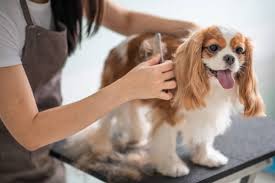Grooming isn’t just about making your dog look neat it’s about keeping them healthy, comfortable, and happy. Regular brushing helps prevent mats, nail trims support healthy posture, ear care reduces infection risks, and bathing keeps the skin barrier in balance.
The good news? You don’t need an expensive salon setup at home. A handful of essential tools can help you build a safe, simple grooming routine.In this guide, we’ll cover the must-have dog grooming tools, how to choose them, how to use them, and how often you need each.

1) Grooming Brush: First Line of Skin & Coat Care
Why it matters:
Brushing lifts dirt, distributes natural oils, reduces shedding, and—most importantly—prevents painful mats, especially in curly or long coats (e.g., Poodles, Cavapoos).
How to choose:
- Short/straight coats: soft bristle or rubber curry brushes
- Curly/wavy or double coats: slicker-style or pin brushes
- Sensitive skin: look for rounded pins and flexible pads
How to use (2–5 min sessions):
- Start at the neck, brush with the hair growth.
- Work in small sections; be gentle over bony areas.
- For longer coats, “line brush”: lift a thin layer of hair and brush the hair underneath.
Suggested option: A versatile everyday brush like the Grooming Brush is a practical starting point for most coats.
Frequency guide:
- Short coat: 2–3× per week
- Long/curly coat: daily or every other day
- Heavy shedders: daily during shedding season
2) Dog Shampoo: Clean Without Stripping the Skin
Why it matters:
Human shampoos can disrupt a dog’s skin pH and cause dryness. A dog-formulated shampoo cleans while preserving the skin barrier.
How to choose:
- Normal skin: gentle, everyday formula
- Dry/itchy: moisturizing or oatmeal-based
- Odor control: deodorizing (avoid heavy perfume if sensitive)
- Puppies: tear-free, mild formula
How to use (5–8 min):
- Wet thoroughly; lukewarm water only.
- Dilute shampoo (1:5–1:10 with water) for even coverage.
- Massage, avoid eyes/ears, rinse until water runs clear.
Suggested option: Fresh Pet Shampoo—a gentle, dog-safe choice suitable for routine baths.
Frequency guide:
- Typical pet: every 3–6 weeks (more often if muddy, less if very dry skin)
- Active/outdoor dogs: as needed—always follow with a thorough rinse and dry
3) Ear Cleansing Wipes: Small Habit, Big Prevention
Why it matters:
Wax, moisture, and debris raise infection risk—especially for floppy-eared breeds. Routine wipe-downs help keep ears comfortable.
How to choose:
- Alcohol-free for comfort
- Gentle cleansing agents; lightly moisturizing is OK
- Wipes vs. liquid: wipes are beginner-friendly and less messy
How to use (1–2 min per ear):
- Wipe the visible ear flap and outer canal (only what you can see).
- Never insert cotton swabs deep into the ear.
- If you smell strong odor, see redness, or your dog shakes/scratches persistently, ask your vet.
Suggested option: TP Pro Ear Cleansing Wipes are convenient for weekly maintenance and quick, post-swim cleanups.
Frequency guide:
- Weekly for most dogs
- After swimming/baths for moisture-prone pups
4) Absorbent Bath Towels: Faster Drying, Happier Skin
Why it matters:
Quick drying reduces chill, prevents that “wet dog” smell lingering in the undercoat, and shortens blow-dry time if you use one.
How to choose:
- Microfiber for superior absorption
- Large enough to wrap your dog; edge stitching for durability
How to use (2–5 min):
- Press and squeeze rather than rubbing to avoid tangles.
- For long coats, towel first, then brush while slightly damp.
Suggested option: Bath Towels designed for pets are a practical staple for every bath.
Frequency guide:
- Every bath; keep one dedicated towel per pet to minimize cross-contamination
5) Nail Clippers: Comfortable Paws, Better Posture
Why it matters:
Overgrown nails can lead to splayed toes, altered gait, and joint strain. Regular trims keep walking comfortable.
How to choose:
- Guillotine style: small/medium dogs, easy to control
- Scissor style: thicker nails, large breeds
- Safety guard: helpful for beginners
- Grinders (optional): smooth edges, great for black nails
How to trim (3–6 min):
- Take tiny slivers—stop when you see a pale oval/softer center.
- Keep styptic powder nearby for accidental nicks.
- Reward after each paw to keep it positive.
Suggested option: The Pet Nail Clipper is beginner-friendly and works for routine trims.
Frequency guide:
- Every 2–4 weeks (tap-tap on floors = time to trim)
6) Flea Comb: Small Tool, Big Insight
Why it matters:
A fine-tooth flea comb helps you detect early (before itching escalates), remove flea dirt, and catch debris around the face and paws.
How to choose:
- Dense, fine teeth; ergonomic handle
- Rust-resistant metal teeth
How to use (1–3 min passes):
- Comb along the back, tail base, belly, and neck.
- Wipe the comb on a damp white paper towel—brown specks that turn reddish may indicate flea dirt.
Suggested option: Add a Flea Comb to your weekly check—especially useful after outdoor play.
Frequency guide:
- Weekly checks; daily during flea season or if you notice scratching
Helpful Add-Ons (Highly Recommended)
- Deshedding Tool: Speeds up seasonal coat blow for double-coated breeds.
- Styptic Powder: Clots minor bleeding if you nick the quick during a nail trim.
- Dog Toothbrush & Toothpaste: Daily brushing cuts plaque; flavored pastes help cooperation.
- Quiet Clippers: For light sanitary trims and tidying feet/face on long coats.
- Conditioning Spray/Detangler: Mist lightly before brushing to reduce static and breakage.
Tip: If you’re just starting, build slowly—brush + shampoo + ear wipes + towels + nail clippers + flea comb cover 95% of home care needs.
A Simple, Stress-Light Home Grooming Routine (30–45 minutes)
- Quick check: Eyes, ears, skin, nails.
- Line brush: Work in sections; use a light detangling spray if needed.
- Flea-comb pass: Tail base, belly, neck—wipe comb on a damp towel to check for flea dirt.
- Bath: Diluted Fresh Pet Shampoo; rinse thoroughly.
- Dry: Pat dry with Bath Towels; finish with a brief brush-through.
- Ears: Wipe gently with TP Pro Ear Cleansing Wipes—only what you can see.
- Nails: Trim with Pet Nail Clipper; tiny cuts, reward often.
- Final check: Soft brush pass and a treat so your pup ends on a positive note.
FAQs
1. How often should I groom my dog at home?
Most dogs need brushing 2–3 times per week and a full grooming (bath, nails, ears) every 4–6 weeks. High-shedding or long-haired breeds may need more frequent care.
2. Can I use human grooming tools or products on my dog?
No, human tools and shampoos can damage a dog’s coat and irritate their skin. Always use pet-specific brushes, clippers, and pH-balanced dog shampoo.
3. Is it safe to trim my dog’s nails at home?
Yes if you use proper dog nail clippers or a grinder and avoid cutting the quick (the pink, sensitive part). Regular trimming prevents pain, joint issues, and scratches.
4. Are dog grooming clippers worth buying for home grooming?
Absolutely. If your dog requires regular haircuts, investing in a quiet, pet-safe clipper can save grooming costs and reduce stress for both of you.
Having the right dog grooming tools at home isn’t just a convenience it’s essential for your pup’s comfort, hygiene, and overall well-being. Whether you’re brushing out tangles, trimming nails, or giving a refreshing bath, using the proper tools makes a world of difference in your dog’s grooming experience.
If you’re looking for trusted, high-quality grooming essentials, Luluspot is your go-to destination. From ergonomic brushes to vet-approved shampoos and quiet clippers, Luluspot offers a curated collection of grooming tools every pet parent needs all in one convenient place.
👉 Visit Luluspot today and upgrade your home grooming kit with tools your dog will love (and thank you for)!
